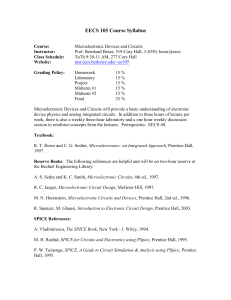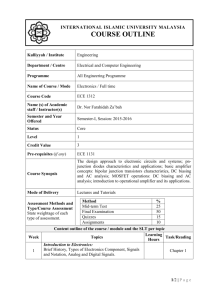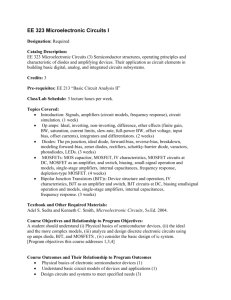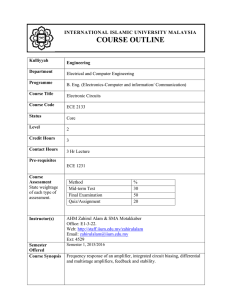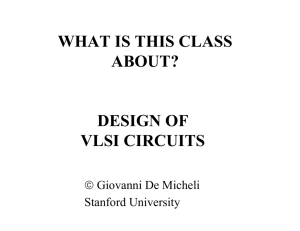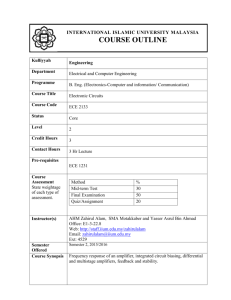Microelectronic Circuits Ch. 1 Introduction INHA Univ.
advertisement
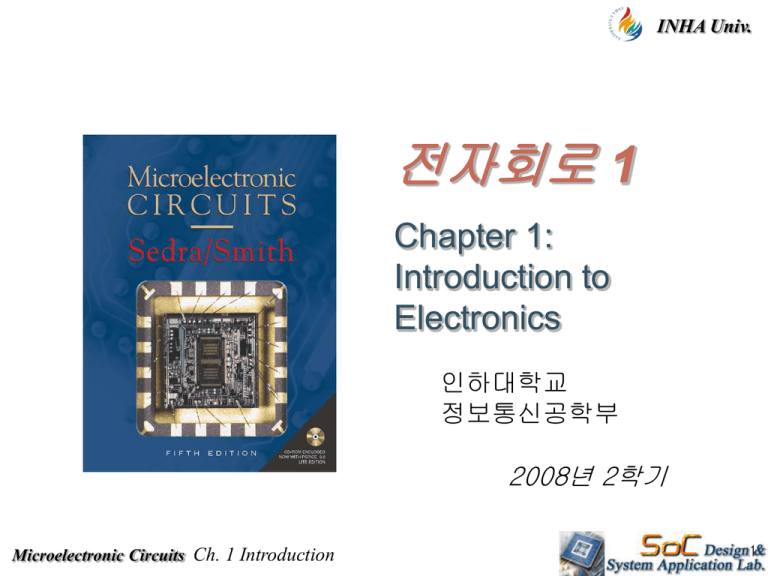
INHA Univ. 전자회로 1 Chapter 1: Introduction to Electronics 인하대학교 정보통신공학부 2008년 2학기 Microelectronic Circuits Ch. 1 Introduction 1 Course Administration Professor: 정 덕진 INHA Univ. Office: Hi-Tech 빌딩 510호 TEL: (032) 860-7435 Email: djchung@inha.ac.kr http://vlsi.inha.ac.kr/ Class Web Site: Cyber-class in Inha Univ. Microelectronic Circuits Ch. 1 Introduction 2 Text and Reference books INHA Univ. Text: Microelectronics Circuits (5th Edition), Sedra/Smith Class notes on the web site – Cyber-class in Inha Univ. Reference: Microelectronic Circuits Ch. 1 Introduction 3 Course Contents INHA Univ. Part I. Devices and Basic Circuits Ch.1. Introduction to Electronics • Definition about signal / Analog-digital / Continuous-Discrete 등 Ch 2. Operational Amplifiers (OP-AMP) • • Ideal OP-AMP Practical OP-AMP 및 연결방법 Ch. 3. Diodes • • Ideal Diode Practical Diode condition 및 회로 / 특수 Diode / Zener Diode Ch. 4. MOS Field-Effect Transistors (MOSFETs) • 물리적인 특성, MOSFET circuits, amplifiers Ch. 5. Bipolar Junction Transistors (BJTs) • • • 물리적인 특성, npn/ pnp Tr., BJT circuits, small-signal operation and models, BJT amplifiers Microelectronic Circuits Ch. 1 Introduction 4 Course Contents INHA Univ. Part II, Analog and Digital Integrated Circuits Ch. 6. Single-Stage Integrated-Circuit amplifiers Ch. 7. Differential and Multistage Amplifiers Ch. 8. Feedback Ch. 9. Operational-Amplifier and Data-Converter Circuits Ch. 10. Digital CMOS Logic Circuits Microelectronic Circuits Ch. 1 Introduction 5 INHA Univ. Grading Information Grade determinants Quiz/Homeworks ~ 10% – Will be scheduled later. Exam-2 ~ 25% – Will be scheduled later Final Exam ~ 25% – Will be scheduled later Projects ~ 30% – Due at the beginning of class on the due date (No extensions). 출석 Microelectronic Circuits Ch. 1 Introduction ~ 10% 6 INHA Univ. Chapter 1 Introduction to Electronics Microelectronic Circuits Ch. 1 Introduction 7 Introduction INHA Univ. Microelectronics: 작은 실리콘 (실리콘 칩)에 수백만개의 회로를 만들수 있는 능력을 가진 Integrated Circuit (IC) technology를 말한다. Microelectronics circuit example: Microprocessor – Intel Pentium, AMD Athlon, DRAM, CDMA modem chip, ASIC, FPGA etc. Chapter 1 에서 배울점. Basic concept와 terminology를 이해하며, 주로 단일소자를 이용한 signal amplification (증폭)에 중점을 둔다. Linear amplifier에 대한 모델들을 이해하고, 그 모델을 이용해서 실질적인 amplifier circuits (증폭회로)들을 설계하고 분석한다. Microelectronic Circuits Ch. 1 Introduction 8 The Transistor Revolution INHA Univ. First transistor Bell Labs, 1948 Microelectronic Circuits Ch. 1 Introduction 9 The First Integrated Circuits INHA Univ. Bipolar logic 1960’s ECL 3-input Gate Motorola 1966 Microelectronic Circuits Ch. 1 Introduction 10 Intel 4004 Micro-Processor INHA Univ. • First microprocessor designed In 1971 • 1000 transistors • 1 MHz operation Microelectronic Circuits Ch. 1 Introduction 11 Intel Pentium (IV) Microprocessor INHA Univ. • Released in 2000 • 42 million transistors • 0.18 micron tech. • > 1GHz Microelectronic Circuits Ch. 1 Introduction 12 INHA Univ. Silicon Wafer Single die Wafer Microelectronic Circuits Ch. 1 Introduction 13 INHA Univ. Transistor Counts 1 Billion Transistors K 1,000,000 100,000 10,000 1,000 i486 i386 80286 100 10 Pentium® III Pentium® II Pentium® Pro Pentium® 8086 Source: Intel 1 1975 1980 1985 1990 1995 2000 2005 2010 Projected Courtesy, Intel Microelectronic Circuits Ch. 1 Introduction 14 INHA Univ. Design Abstraction Levels SYSTEM MODULE + GATE CIRCUIT DEVICE G S n+ Microelectronic Circuits Ch. 1 Introduction D n+ 15 Signals INHA Univ. Signals: 정보를 포함한 신호 signal processing : 정보를 추출, 가공, 전송하는 과정 – Acoustic signal – Electrical signal – Optical signal 여기서는 주로 Electrical signal을 취급한다. Microelectronic Circuits Ch. 1 Introduction 16 INHA Univ. 1.1 Signals In Fig.1.1(a), Signal is represented by a voltage Vs(t) having a source resistance Rs. Rs 0 Rs Figure 1.1 Two alternative representations of a signal source: (a) the Thévenin form, and (b) the Norton form. Microelectronic Circuits Ch. 1 Introduction 17 INHA Univ. Vs(t) = Rs is(t) Figure 1.2 An arbitrary voltage signal vs(t). Microelectronic Circuits Ch. 1 Introduction 18 1.2 Frequency Spectrum of Signals INHA Univ. 1) Signal 의 표시방법 1)-1. Time Domain Va(t) = Va sin t Figure 1.3 Sine-wave voltage signal of amplitude Figure 1.4 A symmetrical squareVa and frequency f = 1/T Hz. wave signal of amplitude V. The angular frequency = 2f rad/s. Microelectronic Circuits Ch. 1 Introduction 19 INHA Univ. 1)-2. Frequency domain • Fourier series와 Fourier transform에 의하여 frequency spectrum이라는 신호표현이 얻어진다. • 모든 signal은 Fourier transform에 의해 서 주파수 영역으로 구분 가능 Figure 1.5 The frequency spectrum (also known as the line spectrum) of the periodic square wave of Fig. 1.4. Microelectronic Circuits Ch. 1 Introduction 20 2)-2. Frequency domain INHA Univ. a0 t t an cos 2n bn sin 2n 2 n1 T T 예) 2 2nt an 0T f (t ) cos dt T T 2 2nt bn 0T f (t ) sin dt T T 2 w 즉. Fig. 1-4의 파형은 ( 0 ) T 4v 1 1 v(t ) (sin wot sin 3wot sin 5wot ) 3 5 1 sin wot : fundamental frequency sin 3wot : 3rd harmonic frequency 3 1 sin 5wot : 5th harmonic frequency 5 실효치(Root-Mean-Square, rms)로써 표시되기도 하며 sine wave시 peak 치의 1 이다 2 audio band : 20 ㎐~ 20 ㎑ (20 ㎑ 이상은 사람의 귀에서 인식 불가능) Microelectronic Circuits Ch. 1 Introduction 21 INHA Univ. Unlike the case of periodic signals, where the spectrum consists of discrete frequencies (at 0 and its harmonics), the spectrum of nonperiodic signal contains in general all possible frequencies, that is continuous function of frequencies. Figure 1.6 The frequency spectrum of an arbitrary waveform such as that in Fig. 1.2. Microelectronic Circuits Ch. 1 Introduction 22 1.3 Analog and Digital Signals 특성에 의한 분류 Analog signal : Fig. 1.2 Digital signal : 형태에 의한 분류 Continuous-time signal : Discrete-time signal : Digital signal의 장점 noise에 의한 문제를 쉽게 치유가능 저전력으로 전송가능 Microelectronic Circuits Ch. 1 Introduction INHA Univ. 23 INHA Univ. Analog Signal Sampling: At each intervals along the time axis we have marked the time instants t0, t1, t2, and so on. At each of these time instants the magnitude of the signal is measured. Continuous-time signal Discrete-time signal Figure 1.7 Sampling the continuous-time analog signal in (a) results in the discrete-time signal in (b). Microelectronic Circuits Ch. 1 Introduction 24 Digital Signal INHA Univ. After quantized, discretized, or digitized, the resulting digital signal is a sequence of numbers that represent the magnitude of the successive signal samples. Binary number system results in the simplest possible digital signals and circuits. In binary system, each digit in the number takes on one of only two possible values, denoted 0 and 1. Figure 1.8 Variation of a particular binary digital signal with time. From http://www.amd.com Microelectronic Circuits Ch. 1 Introduction 25 Analog-to-Digital (A/D) Converter INHA Univ. A/D converter accepts at its input the samples of an analog signal and provides for each input sample the corresponding N-bit digital representation at its N output terminals. Microelectronic Circuits Ch. 1 Introduction 26 INHA Univ. 1.4 Amplifiers Signal Amplification Signal을 증폭할 때 선형성이 유지되어야 하며, 선형성이 유지되지 않으면 Nonlinear Distortion 이 발생. vo (t ) Avi (t ) Transfer characteristic of a linear amplifier A : Amplifier gain, 만약 A=const. 이면 linear Amplifier 라고 부른다. Voltage gain (Av) ≡ vo vi , current gain (Ai) ≡ io , ii power gain (Ap) ≡ PL voio Pi viii ∴ Ap = Av Ai Microelectronic Circuits Ch. 1 Introduction 27 INHA Univ. Expressing Gain in Decibels Voltage gain in decibels = 20 log |Av| dB Current gain in decibels = 20 log |Ai| dB Power gain in decibels = 10 log |Ap| dB A negative gain Av means that there is a 180º phase difference between input and output signals. Amplifier Power Supplies DC power Pdc V1I1 V2 I 2 Pdc Pi PL Pdissipated PL 100 | Pdc Pi 0 : amplifier efficiency V+ = 10V, V- = -10V Vo = Vpeak, RL=1K Microelectronic Circuits Ch. 1 Introduction 28 Example 1.1 INHA Univ. V+ = 10V, V- = -10V Vo = Vpeak, RL=1K, I1 I 2 9.5mA Av vo 9V peak 9 Vi 1V peak Av 20 log10 9 19.1dB vo 9V peak 9mApeak RL 1k Io PL Vorms I orms AP Vi 1Vpeak Ii 0.1mA Ai Ii 9 9 40.5mW 2 2 PL 40.5 810W / W PI 0.05 Io 9 90 0.1 Ai 20 log 90 39.1dB PI Virms I irms 1 0.1 0.05mW 2 2 AP 10 log 80 29.1dB Pdc 10 9.5 10 9.5 190mW Pdissipated Pdc PI PL 190 0.05 40.5 149mW PL 100 21.3% Pdc Microelectronic Circuits Ch. 1 Introduction 29 INHA Univ. Amplifier Saturation The output voltage cannot exceed a specified positive limit and cannot decrease below a specified negative limit. L+ : Positive saturation level L-: Negative saturation level Note that the peaks of the larger waveform have been clipped off because of amplifier saturation. Figure 1.13 An amplifier transfer characteristic that is linear except for output saturation. Microelectronic Circuits Ch. 1 Introduction 30 Nonlinear Transfer Characteristic and Biasing INHA Univ. Figure 1.14 (a) An amplifier transfer characteristic that shows considerable nonlinearity. (b) To obtain linear operation the amplifier is biased as shown, and the signal amplitude is kept small. Observe that this amplifier is operated from a single power supply, VDD. • In practical amplifiers the transfer characteristic may exhibit nonlinearities of various magnitude. • The transfer characteristic is nonlinear and, because of the single-supply operation, is not centered around origin. • Biasing: signal의 전부분이 증폭될 수 있도록 DC voltage를 부가하여 중심점을 옮기는 것. • See page.19. Microelectronic Circuits Ch. 1 Introduction 31 Example 1.2 v 10 10 e 11 INHA Univ. ( for v 0V and v 0.3V ) 40 vI 0 I O Find the limits L- and L+ and the corresponding v Find the VI that results in VO = 5V and the voltage gain at the corresponding operating point I 1) L- = 0.3V, v = 0.3V in Eq. (1.10) v = 0.690V O I 2) L+ = 10 10 11 10V 3) VI = 0.673V by substituting v = 5V in Eq. (1.10) O 4) Av = -200 V/V by evaluating the derivative dv / dv at v = 0.673V O I I Figure 1.15 A sketch of the transfer characteristic of the amplifier of Example 1.2. Note that this amplifier is inverting (i.e., with a gain that is negative). Microelectronic Circuits Ch. 1 Introduction 32 Symbol Convention INHA Univ. IA: Direct-current (dc) current VC: Direct-current (dc) Voltage iA(t): Instantaneous current (Total current) iC(t): Incremental current signal VDD: Power-supply (dc) voltage IDD: dc current drawn from the power supply Microelectronic Circuits Ch. 1 Introduction 33 INHA Univ. Circuit Models for Amplifiers Circuit Model의 4가지 유형 Ro Vi Ri Ri A vo V i Voltage Amplifier (Avo : unitless) Ri G m Vi A isii Ro Current Amplifier (Ai : unitless) ii io Vi ii Ro Transconductance Amplifier (Gm : conductance) Microelectronic Circuits Ch. 1 Introduction Ro Ri R m ii Vo Resistance Amplifier (Rm : Resistance) 34 1.5.1 Voltage Amplifiers INHA Univ. Figure 1.17 (a) Circuit model for the voltage amplifier. (b) The voltage amplifier with input signal source and load. Microelectronic Circuits Ch. 1 Introduction 35 INHA Univ. The Four Amplifier Types ii Ro Vi Ri Ri A vo V i Voltage Amplifier (Avo : unitless) Ri G m Vi Ro Current Amplifier (Ai : unitless) ii io Vi A isii Ro Transconductance Amplifier (Gm : conductance) Microelectronic Circuits Ch. 1 Introduction Ro Ri R m ii Vo Resistance Amplifier (Rm : Resistance) 36 INHA Univ. Frequency Response of Amplifiers Amplifier frequency response: 다른 주파수들을 가지고 있는 Input sinusoids에 대한 응답에 관한 특성. Measuring the Amplifier Frequency Response Figure 1.20 Measuring the frequency response of a linear amplifier. At the test frequency v, the amplifier gain is characterized by its magnitude (Vo/Vi) and phase . Fig. 1.20 depicts a linear amplifier fed at its input with a sine-wave signal of amplitude Vi and frequency Whenever a sine-wave signal is applied to a linear circuit, the resulting output is sinusoidal with the same frequency as the input. Linear Amplifier에서는 gain이 일정하나 일반적인 Amplifier에서는 frequency 에 따라 증폭율이 달라진다. Microelectronic Circuits Ch. 1 Introduction 37 Measuring the Amplifier Frequency Response INHA Univ. Figure 1.20 Measuring the frequency response of a linear amplifier. At the test frequency , the amplifier gain is characterized by its magnitude (Vo/Vi) and phase . Magnitude of the amplifier gain (or transmission), or transfer function |T()| = Vo/Vi Phase of the amplifier transmission: T() = Amplifier의 Frequency response는 amplitude response와 phase response를 구성한다 Amplitude response: gain magnitude |T()| versus frequency Phase response: phase angle T() versus frequency Microelectronic Circuits Ch. 1 Introduction 38 INHA Univ. 1.6.2 Amplifier Bandwidth Figure 1.21 Typical magnitude response of an amplifier. |T()| is the magnitude of the amplifier transfer function—that is, the ratio of the output Vo() to the input Vi(). Express the magnitude of transmission in decibels The gain is almost constant over a wide frequency range, roughly between 1 and 2. Amplifier bandwidth: The band of frequencies over which the gain of the amplifier is almost constant. Microelectronic Circuits Ch. 1 Introduction 39 1.6.3 Evaluating the Frequency Response of Amplifiers INHA Univ. In frequency-domain analysis C C Vi C c bc S C Vo be C E the Amplifier transfer function T (w) = Vo()/Vi() Microelectronic Circuits Ch. 1 Introduction 40 INHA Univ. 1.6.4 Single-Time-Constant Networks Two examples of STC networks are Low-pass network High-pass network Figure 1.22 Two examples of STC networks: (a) a low-pass network and (b) a high-pass network. Microelectronic Circuits Ch. 1 Introduction 41 INHA Univ. Low-pass network R Vi Vo C 20 log 1 2 w 1 w2 tan 1 1 1 Vo 1 jwC T ( w) w 1 Vi R jwCR 1 j 1 wo jwC | w 20 log wo 1 1 3dB 2 1 RC w w | wo wo Vo ( s ) Vi ( s ) The transmission of low-pass network will decrease with frequency and approach zero as approach . Low-pass filter passes low-frequency sine-wave inputs with little or no attenuation (at =0, the transmission is unity) jw 대신에 complex frequency variable s w0 Microelectronic Circuits Ch. 1 Introduction T (s) 42 INHA Univ. Bode plots of Low-pass network Magnitude response 3-dB frequency (0) = corner frequency = break frequency Phase response Microelectronic Circuits Ch. 1 Introduction 43 INHA Univ. High-pass network Vi Vo R jw 1 Vi R 1 jw jwC RC 1 w 1 tan 1 o w 1 j ( wo / w) 1 ( wo / w) 2 T ( w) C R Vo w0 예) C = 1 ㎋ , R = 1 ㏀ 1 RC 1 1 6 sol) wo 1 10 Its transmission is unity at RC 103 109 106 = and decrease as is wo f o 3dB frequency 159 KHz reduced. 2 6 1 s 1 10 Transfer function : T ( s) tan ( ) 6 6 2 w s 10 1 (10 / w) Microelectronic Circuits Ch. 1 Introduction 44 Bode plots of High-pass network INHA Univ. Magnitude response Phase response Microelectronic Circuits Ch. 1 Introduction 45 Example 1.5 INHA Univ. a) Amplifier voltage gain V0 / VS , dc gain and the 3-dB frequency ? = 144V/VkΩ , Ro = 200Ω , RL = 1kΩ, b) RS = 20kΩ, Ri = 100kΩ, Ci = 60pF, Calculate dc gain, 3-dB frequency, unit gain frequency ? c) V0 = ? i) Vi = 0.1 sin102t V ii) Vi = 0.1 sin105t V iii) Vi = 0.1 sin106t V iv) Vi = 0.1 sin108t V Microelectronic Circuits Ch. 1 Introduction 46 Example 1.5: Solution (see pp. 36) a) INHA Univ. Zi 1 1 Vs Vs 1 Z i Rs 1 RsYi 1 Rs ( sCi ) Ri 1 1 Vi 1 Rs 1 sCi Rs || Ri Vs (1 Rs ) sC R 1 i s Ri Ri Vi Vs Vo Vi RL RL Ro 1 1 1 Vi R R Vs 1 s 1 o 1 sCi Rs || Ri Ri RL 1 Time constant Ci ( Ro || Ri ) wo Vo 1 1 1 K R R w w Vs 1 s 1 o 1 j 1 j Ro RL wo wo Microelectronic Circuits Ch. 1 Introduction 47 Example 1.5: Solution (see pp. 36) INHA Univ. b) dc gain K 144 1 1 100V / V 20 200 1 1 100 1000 3 dB frequency wo 1 106 r / s 60 pF (20 K || 100 K) 106 f0 159.2kHz 2 8 unit gain frequency = 10 r / s Microelectronic Circuits Ch. 1 Introduction 48 INHA Univ. Example 1.5: Solution (see pp. 36) c) T ( jw) vo 100 ( jw) vs 1 jw / 106 5 w 1 10 ii) tan tan 5 . 7 wo 106 1 Gain = 2 w 1 10 i ) tan tan 0 6 wo 10 1 vo (t ) 10 sin 2 t 6 w 1 10 iii) tan tan 45 6 wo 10 1 gain 100 1 106 106 2 70.7 vo (t ) 70.7 sin(106 t 45 )V Microelectronic Circuits Ch. 1 Introduction 100 gain 1 2 105 106 9.95 vo (t ) 9.95 sin(105 t 5.7 )V 8 w 1 10 iv) tan tan 89 . 4 wo 106 1 gain 100 1 2 108 106 89.4 vo (t ) 0.1sin(108 t 89.4 )V 49 1.6.5 Classification of Amplifier Based on Frequency Response INHA Univ. Figure 1.26 Frequency response for (a) a capacitively coupled amplifier, (b) a directcoupled amplifier (Low-pass filter), and (c) a tuned or bandpass amplifier (bandpass filter). Microelectronic Circuits Ch. 1 Introduction 50 1.7 Digital Logic Inverters 1.7.1 Function of the Inverter INHA Univ. Figure 1.28 A logic inverter operating from a dc supply VDD. A logical variable is associated with a nominal voltage level for each logic state 1 VOH and 0 VOL Microelectronic Circuits Ch. 1 Introduction 51 INHA Univ. 1.7.2 The Voltage Transfer Characteristic (VTC) VOH VIH “1” Vout VOH Slope = -1 Undefined Region Slope = -1 VIL “0” VOL VOL VIL VIH Vin The regions of acceptable high and low voltages are delimited by VIH and VIL that represent the points where the gain of VTC curve = -1. VIL ~ VIH: transition region Microelectronic Circuits Ch. 1 Introduction 52 1.7.3 Noise Margins INHA Univ. For a gate to be robust and insensitive to noise disturbance, “0” and “1” intervals (noise margins) should be as large as possible. "1" V OH Noise margin high NM H V IH Undefined Region V OL NM L "0" Gate Output Stage M Microelectronic Circuits Ch. 1 Introduction V IL Gate Input Stage M+1 Noise margin low * Noise Margin High NMH = VOH - VIH * Noise Margin Low NML = VIL - VOL 53 1.7.4 Ideal VTC INHA Univ. The ideal gate should have infinite gain in the transition region a gate threshold located in the middle of the logic swing high and low noise margins equal to half the swing input and output impedances of infinity and zero, respectively. g= Ri = Ro = 0 Fanout = NMH = NML = VDD/2 Ideal voltage-transfer characteristic of an Ideal inverter Microelectronic Circuits Ch. 1 Introduction 54 1.7.5 Inverter Implementation INHA Univ. Its Layout CMOS Inverter VDD N Well VDD PMOS 2l Contacts PMOS In Out In NMOS Out Metal 1 Polysilicon NMOS GND Microelectronic Circuits Ch. 1 Introduction 55 INHA Univ. VDD PMOS In Out NMOS Figure 1.31 (a) The simplest implementation of a logic inverter using a voltage-controlled switch; (b) equivalent circuit when vI is low; and (c) equivalent circuit when vI is high. Note that the switch is assumed to close when vI is high. Microelectronic Circuits Ch. 1 Introduction 56 INHA Univ. VDD PMOS In Out NMOS Figure 1.32 A more elaborate implementation of the logic inverter utilizing two complementary switches. This is the basis of the CMOS inverter studied in Section 4.10. Microelectronic Circuits Ch. 1 Introduction 57 1.7.6 Power Dissipation INHA Univ. Power dissipation: how much energy is consumed per operation and how much heat the circuit dissipates Two important power consumption: Dynamic and static power dissipation P (watts) = CLVdd²f01+ tscVddIpeakf01+VddIleakage f01 = P01 fclock Dynamic power dissipation = CLVdd²f01 Static power dissipation = tscVddIpeakf01+VddIleakage – CL: load capacitance Capacitance between the output node and ground – Vdd: power-supply voltage Microelectronic Circuits Ch. 1 Introduction 58 1.7.7 Propagation Delay INHA Univ. Propagation delay: time delay between switching of v1 (from low to high or vice versa) and the corresponding change appearing at the output. Propagation arises for two reasons: – The transistors that implement the switches exhibit finite (nonzero) switching times – The capacitance that is inevitably present between the inverter output node and ground needs to charge (or discharge) before the output reaches its required level of VOH or VOL Microelectronic Circuits Ch. 1 Introduction 59 Modeling Propagation Delay INHA Univ. Model circuit as first-order RC network R vin vout where RC (time constant) Time to reach 50% point is C tp = ln (2) = 0.69 Time to reach 90% point is tp = ln (9) = 2.2 Important model – matches delay of inverter Microelectronic Circuits Ch. 1 Introduction 60 Example 1.6 INHA Univ. Figure 1.34 Example 1.6: (a) The inverter circuit after the switch opens (i.e., for t 0). (b) Waveforms of vI and vO. Observe that the switch is assumed to operate instantaneously. vO rises exponentially, starting at VOL and heading toward VOH . Microelectronic Circuits Ch. 1 Introduction 61 INHA Univ. Solution) iii) i) V V OL offset V V R RR DD offset on on 5 0.1 0.1 0.1 0.55V 1.1 ii) by substituting in Eq. (1.33) v (t ) 5 (5 0.55) e t / O 1 v (t ) (V V ) 2 1 (5 0.55) 2 O PLH OH iv) The result is t 0.69 PLH 0.69 RC 0.6910 10 6.9 ns 3 Microelectronic Circuits Ch. 1 Introduction OL 11 62
